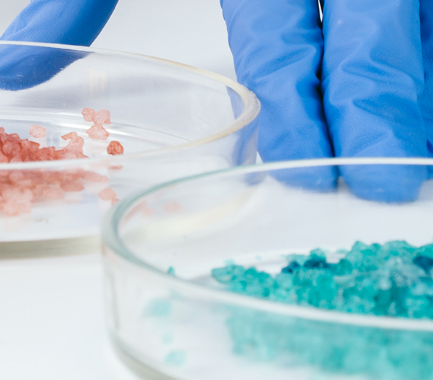Your contact
PENPET-Team - Hamburg

Laurens Rogowski
Sales
Tel. +49 (0) 40 - 675 7 99 80
sales@penpet.de
Get in touch with us.
Neopentyl Glycol (NPG)
Neopentyl Glycol (NPG) is an organic compound that belongs to the dihydric and branched alcohols family. As a raw material for various synthesis processes, it is of great importance for the chemical industry. Neopentyl glycol is obtained from formaldehyde and isobutyraldehyde in a two-stage process. Here, the two starting materials are first combined in an exothermic aldol reaction in a stirred tank reactor to form 3-hydroxy-2,2-dimethylpropanal. The hydrogenation of this intermediate product in the tubular reactor then produces neopentyl glycol.
The alcoholic compound is mainly used as a comonomer for polyester resins, alkyd resins, polyurethanes and synthetic fibers as well as for the manufacture of paints, lubricants, additives and plasticizers. Neopentyl glycol increases the resistance of plastics to heat, water and light.
At PENPET you can order the required quantity of neopentyl glycol (NPG) in an uncomplicated and sustainable way. We look forward to receiving your inquiry for an individual offer. The substance can be delivered as a solid in 25 kg sacks or 500 kg Big Bags or as a 90% solution in tank containers.
Individual weights of the Big Bags are also available on customer request-
CAS no. 126-30-7
EINECS no. 204-781-0
Molecular formula: C5H12O2
Synonyms: Neopentyl Glycol, Neopentyl Glycol, 2,2-dimethyl-1,3-propanediol, 2,2-dimethylpropane-1,3-diol, 2,2-dimethylolpropane, NPG
Areas of application: Production of polyester resins, alkyd resins, polyurethanes, synthetic fibers, plasticizers, additives and lubricants
More Information
Neopentyl glycol (NPG) is a dihydric alcohol whose branched structure is reflected in the alternative designation 2,2-dimethyl-1,3-propanediol. The five carbon atoms of the substance are linked in a cruciform structure, with four branches radiating from the central atom. Starting from the more complex components, the molecules of the compound can be described as dihydroxy-terminated propanediol with two methyl groups attached to the central carbon atom.
Neopentyl glycol has the reactive properties typical of an alcoholic compound and, among other things, undergoes reactions to form ethers, esters and urethanes. The two terminal functional groups also enable the construction of cyclic compounds in a reaction with a suitable reaction partner.
Under standard conditions, neopentyl glycol (NPG) is a white solid in the form of crystalline flakes that has hygroscopic properties and binds moisture. The compound is soluble in water and many organic solvents such as ethanol, diethyl ether, chloroform and benzene. Neopentyl glycol is very temperature resistant. It only goes into the liquid state at a temperature of 128 °C and boils at 208 °C, with a tendency to sublimate even below the melting point. Neopentyl glycol has a pleasant, sweet odor.
Neopentyl glycol (NPG) is extremely chemically and thermally stable. The substance is flammable, but is difficult to ignite in its pure form. However, dust that is thrown up by the powder can form explosive dust-air mixtures with the ambient air. When handling open containers of neopentyl glycol, a sufficient distance to sources of ignition such as open flames, sparks from welding and grinding work, electrical devices, hot surfaces and electrostatic discharges must therefore be ensured. Irritant and hazardous gases are released when the substance burns. Among other things, harmful amounts of carbon monoxide can form.
Neopentyl glycol (NPG) is a mild to moderate skin irritant. Affected parts of the body should be rinsed off quickly with soap and water. Direct contact with the compound can cause slight redness, irritation and pain in the eye, but also severe chemical burns and permanent corneal damage. Permanent impairment of vision cannot be ruled out in the event of heavy exposure. Residues of the substance must be removed immediately by extensively rinsing the eyes with water. Then an ophthalmological treatment should be arranged.
Inhalation of vapors, aerosols and dusts from the compound can cause respiratory irritation and breathing difficulties. Serious damage to the lungs is possible. Swallowing neopentyl glycol can cause irritation and chemical burns to the mucous membranes of the mouth, throat and gastrointestinal tract. Gastrointestinal symptoms such as nausea, vomiting and stomach pain are to be expected. If large amounts are absorbed through the stomach, central nervous system disorders such as dizziness, drowsiness, convulsions, unconsciousness and cardiac and renal dysfunction may also occur. After thoroughly rinsing the mouth, medical treatment should be sought immediately, followed by observation of possible symptoms.
Neopentyl glycol (NPG) is considered to be mildly hazardous to water due to potential harm to aquatic organisms. The compound should not be released into the environment. The local authorities should be notified if the substance leaks into drains, the ground or open water. Neopentyl glycol is not subject to any special transport regulations.
